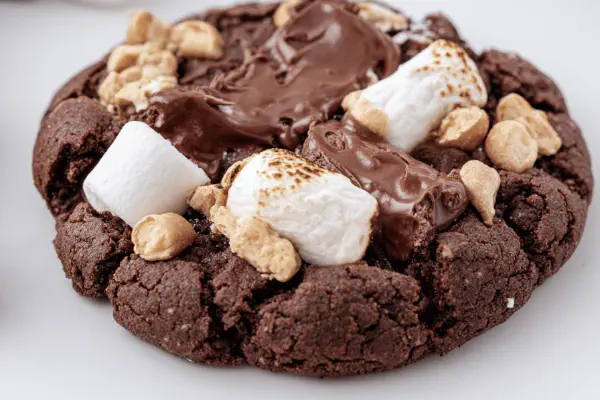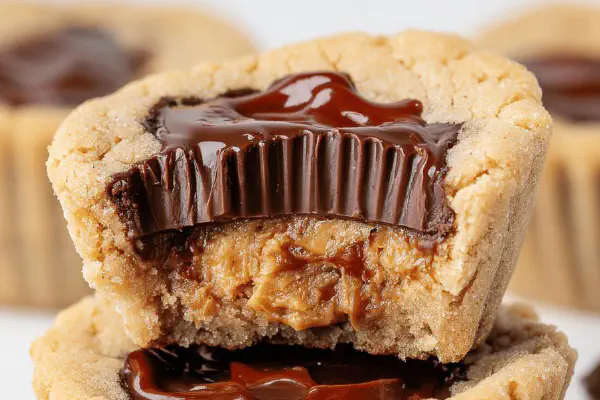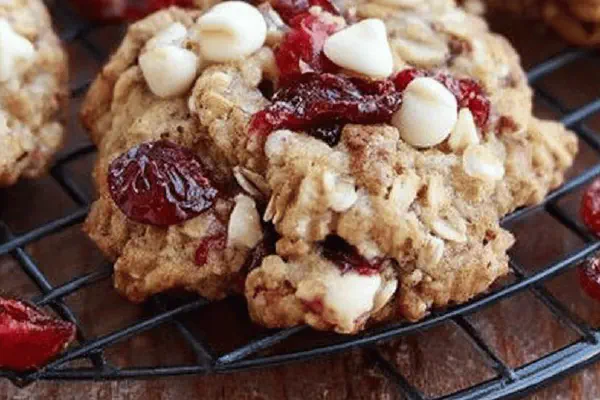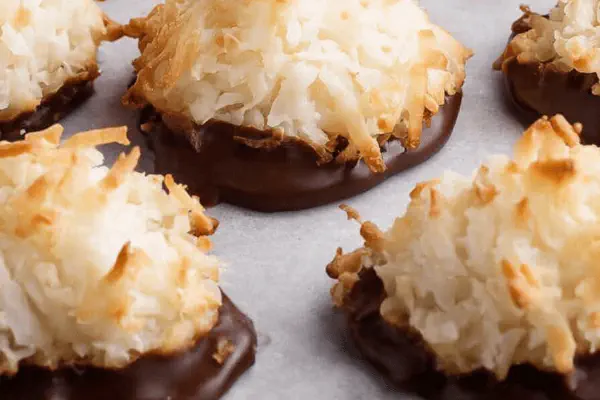Frozen Chocolate Chip Cookies
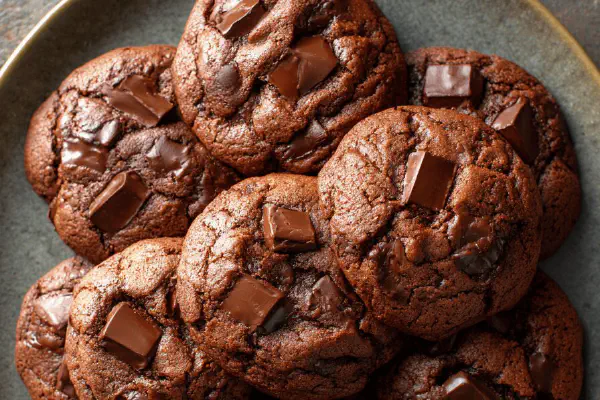
E
By Emma
Certified Culinary Professional
•
Recipe tested & approved
Fudgy, chilled dough sliced into thick discs. Classic choc chips replaced with chunks. Rolled tight, frozen hard. Bake straight from cold, edges firm and golden, centers soft but set. Bicarb swapped with baking powder for a gentler rise. Butter salted for balance but softened less than usual. Sugar reduced slightly to tame sweetness. Recipe yields about two dozen cookies. Times tweaked, details shifted. Step order altered to tighten workflow. Focus on texture cues over the clock. Practical tips on paper choice and dough handling included. Ideal for make-ahead cookie hunger fixes. Sensory notes on color and feel guide final bake. Expect crackly tops and chocolate pockets melting in every bite.
Prep:
25 min
Cook:
13 min
Total:
38 min
Servings:
2 dozen
#cookies
#baking
#chocolate
#frozen dough
#dessert
#snack
Cookies shaped firm, chilled cold. Dough dense, thick silence before the bake. Chocolate chunks in every bite, melting slow. Tried subtle swaps here—baking powder for bicarb, sugar scaled back just enough to soften sweetness barrier. Butter not too soft, to avoid oily mess. Rolling dough cylinder under parchment paper is a game changer—keeps slices perfect, no ragged edges, no crumbles. Freeze times trimmed—no need to wait hours. Slice straight from frozen, bake just enough to see that golden rim forming, but softened centre remains tender. These cookies remember past temp errors—watch dough feel, not only clock. Paper choice matters—waxy or silicone, flaky skins are possible. Give them space on pan, don’t crowd. Let rest off heat for that ideal bite architecture. Cookies are snap and chew balanced. My go-to when frozen dough stash needed.
Ingredients
- 320 ml (1 1/3 cup) unbleached all-purpose flour
- 1.5 ml (1/3 tsp) baking powder
- 170 ml (3/4 cup) semi-sweet chocolate chunks
- 125 ml (1/2 cup) salted butter, slightly chilled, firm but spreadable
- 200 ml (7/8 cup) granulated sugar
- 2.5 ml (1/2 tsp) vanilla extract
- 1 large egg
About the ingredients
Flour measured by volume is forgiving; cups levelled with back of a knife always. Baking powder here gives gentler rise, less dense than sodium bicarbonate. Chocolate chunks provide melty pockets—must resist tiny chips, cookie loses charm fast. Butter slightly chilled prevents spread; too soft leads to puddles. Sugar cut back around 20 ml worth, because in prior batches cookies came out overly sweet and too crisp on edges. Egg must be room temp to blend without stranding. Vanilla intact, essential depth. If no chocolate chunks, use good quality chips sparingly or chuck slightly chopped chocolate bar pieces. Substitute unsalted butter? Add pinch extra salt to dough. Paper choice matters—parchment or silicone liner both work; aluminium foil makes dough stick, never use. Roll dough tightly; loose rolls cause uneven slices and spread.
Method
- 1. Sift flour with baking powder into a bowl. Toss in chunks to coat. Set aside.
- 2. In a large bowl, beat butter and sugar together until creamy but still cool to touch, about 1.5 to 2 minutes. Avoid melting the butter; overheated fat ruins texture.
- 3. Add egg and vanilla. Whip until homogenous, pale yellow body forms. Do not overbeat—avoid adding air that causes flatness later.
- 4. Fold dry mix into wet with a spatula or wooden spoon, slow and steady. Don’t overwork; stop when streaks vanish. Dough should feel dense, slightly tacky, and hold shape.
- 5. Cut dough in half. Lay each half on large pieces of parchment (approx 40 cm long). Shape each into a firm cylinder about 4 cm diameter. Use paper’s edges to roll evenly—tension matters for even slices.
- 6. Twist paper ends tightly like candy wrappers, press dough cylinders to firm them. Refrigerate at least 1 hour or freeze minimum 90 minutes until very firm but not frozen rock solid.
- 7. Preheat oven to 175 °C (350 °F); middle rack best. Prepare sheet pan with parchment or silicone liner. Avoid greasing—cookies spread best without excess fat on pan.
- 8. Trim one roll’s ends if uneven, slice cold dough into 2 cm thick rounds. Keep slices thick so centers stay soft while edges crisp up. Place 10–12 slices per pan with gaps.
- 9. Bake 11 to 14 minutes. Listen for faint crack sounds, edges gently browning, centers set but slightly soft to the touch. Residual heat finishes the cook once out of oven.
- 10. Cool on pan 5 minutes, then transfer to wire rack. Patience key here—breaking too soon ruins shape. Cookies firm up as they cool.
- 11. Repeat slicing and baking with second roll. Store leftovers wrapped tight in fridge or freeze slices for up to 2 weeks.
Cooking tips
Cream butter and sugar until well combined but still cool—overheating fat ruins dough texture and cookie rise. Add egg and vanilla slowly to avoid over aeration, which leads to flat cookies. Folding dry ingredients done gently—overmixing wets gluten and stiffens dough. Rolling dough in parchment ensures smooth cylinder, easier slicing, and no mess. Freezing time flexible but aim for firm dough that slices cleanly without smushing. Baking time varied slightly per oven; rely on visual cues—edges golden, middles set but soft. Leaving cookies too long dry out centres; pull promptly. Cooling on pan stabilizes edges then transferring prevents sogginess. Slice width and dough temperature key to cookie shape and texture—keep dough cold. Saving sliced dough in freezer lets you bake fresh batches anytime. Avoid crowding pans; cookies merge. Practice slice uniformity for even bake.
Chef's notes
- 💡 Butter needs to be chilled slightly firm, not soft or melted; too warm and dough spreads thin, edges burn fast. Keep mixing time short - creamy texture but cool to touch. Overbeating egg and vanilla introduces air, flattens cookie, breaks that dense chew. Fold dry mix slow, watch for streaks gone—overmixing toughens dough. Chunks coat in flour, stops sinking—don’t skip this step. Dough shape matters: roll tight cylinders with parchment for clean slices. Refrigerate minimum an hour, better if extra, freeze if short on time. Slicing frozen dough keeps shape, thick slices hold soft middle while edge crisps.
- 💡 Paper choice changes outcome bigtime. Parchment or silicone are best; avoid foil—sticking and ripping happen. Rolling dough inside paper helps cylinder stay firm and neat, no ragged edges. Twist paper ends tight like candy wrappers—pressure firms dough. Dough temperature key, slice straight from frozen cold enough otherwise squish and uneven pieces happen. Don’t layer slices close or merge on pan. Gaps spell even baking and proper crisp edges. Baking cues over clock; listen for faint cracks, smell rich butter aroma, check edges gold, middle soft still. Pull too soon means dough collapse, too late dry center.
- 💡 Sugar slightly reduced from usual simplifies cookie sweetness and softens crisp edges. Granulated sugar mix with butter till creamy, not grainy rough. Baking powder over bicarbonate gives gentler rise, air bubbles smaller, crumb structure more tender and less puffy. Vanilla extract positive note but low volume maintains depth without sweetness overload. Egg should be room temp to incorporate smoothly without strands or lumps. Substitute unsalted butter? Add pinch salt to realign flavor balance.
- 💡 Rolling dough into cylinders is patient but worth it—long parchment sheets about 40 cm, tight rolls. Use back of knife to level flour measuring cups, accuracy matters here despite volume use. Chocolate chunks better than chips; melt pockets while cookies bake, keep cookie moist looking inside. If chunks not an option, chip substitutes or tiny chopped bar pieces allowed to vary melt pattern. Freezing times flexible but aim for firm feel that slices neat; mushy cold rolls crush dough and slices crumble.
- 💡 Cooling is underrated. Cooling on pan five minutes lets edges firm up, prevents breaking when transferring. Rushing breaks dough shape, crumbs everywhere. Second pan repeat same care; baking in batches pays off for freshness. Storage options: slices freeze well for up to two weeks in airtight wrap; thaw partially in fridge before baking for smoother slice. Snacks ready anytime without dough mess. Avoid overcrowding fridge container or dough merges and texture suffers.
Common questions
Why baking powder not baking soda?
Baking powder gives gentler lift. Less rise, finer crumb. Soda reacts fast and sharp. Here, slower, softer puff wanted. Less dense, not cakey. Balance.
Can I use chocolate chips instead chunks?
Chips usable but lose melty pockets. Chunks melt better, create blobs. Chips melt less, cookie texture changes. Chunks resist losing charm, swelling with moisture.
Dough too soft to slice?
Chill more. Ideally fridge 1+ hour or freeze 90 min. Warm dough sticks, crumbles, messy slices. If rush, roll tighter or refrigerate longer.
Best way to store leftovers?
Wrap singles airtight fan-style in fridge 3-5 days. Freeze slice-wrapped tightly up to two weeks. Thaw slightly before baking. Crisper hold down below zero temp.
